产品中心
当前位置:首页>产品中心Anti-CTLA4
货号: bs-10006R 基本售价: 780.0 元 规格: 50ul
- 规格:50ul
- 价格:780.00元
- 规格:100ul
- 价格:1380.00元
- 规格:200ul
- 价格:2200.00元
产品信息
- 产品编号
- bs-10006R
- 英文名称
- CTLA4
- 中文名称
- 细胞毒性T细胞抗原-4抗体
- 别 名
- CD 152; CD152; CD152 antigen; Celiac disease 3; CELIAC3; CTLA 4; CTLA-4; Cytotoxic T cell associated 4; Cytotoxic T lymphocyte associated 4; Cytotoxic T lymphocyte associated antigen 4; Cytotoxic T lymphocyte associated protein 4; Cytotoxic T lymphocyte associated serine esterase 4; Cytotoxic T lymphocyte protein 4; Cytotoxic T-lymphocyte-associated antigen 4; Cytotoxic T-lymphocyte-associated protein 4; GSE; IDDM12.

- Specific References (1) | bs-10006R has been referenced in 1 publications.[IF=4.12] Seike, Masahiro, et al. "Histamine suppresses regulatory T cells mediated by TGF‐β in murine chronic allergic contact dermatitis." Experimental Dermatology(2015). IHC-F ; Mouse.PubMed:25651189
- 规格价格
- 50ul/780元购买 100ul/1380元购买 200ul/2200元购买 大包装/询价
- 说 明 书
- 50ul 100ul 200ul
- 研究领域
- 抗体来源
- Rabbit
- 克隆类型
- Polyclonal
- 交叉反应
- Human, Mouse, Rat, Dog, Cow, Rabbit, Sheep,
- 产品应用
- WB=1:500-2000 ELISA=1:500-1000 Flow-Cyt=1μg/Test (石蜡切片需做抗原修复)
not yet tested in other applications.
optimal dilutions/concentrations should be determined by the end user.
- 分 子 量
- 21kDa
- 细胞定位
- 细胞膜 细胞外基质
- 性 状
- Lyophilized or Liquid
- 浓 度
- 1mg/ml
- 免 疫 原
- KLH conjugated synthetic peptide derived from human CTLA-4/CD152:75-170/223 <Extracellular>
- 亚 型
- IgG
- 纯化方法
- affinity purified by Protein A
- 储 存 液
- 0.01M TBS(pH7.4) with 1% BSA, 0.03% Proclin300 and 50% Glycerol.
- 保存条件
- Store at -20 °C for one year. Avoid repeated freeze/thaw cycles. The lyophilized antibody is stable at room temperature for at least one month and for greater than a year when kept at -20°C. When reconstituted in sterile pH 7.4 0.01M PBS or diluent of antibody the antibody is stable for at least two weeks at 2-4 °C.
- PubMed
- PubMed
- 产品介绍
- background:
This gene is a member of the immunoglobulin superfamily and encodes a protein which transmits an inhibitory signal to T cells. The protein contains a V domain, a transmembrane domain, and a cytoplasmic tail. Alternate transcriptional splice variants, encoding different isoforms, have been characterized. The membrane-bound isoform functions as a homodimer interconnected by a disulfide bond, while the soluble isoform functions as a monomer. Mutations in this gene have been associated with insulin-dependent diabetes mellitus, Graves disease, Hashimoto thyroiditis, celiac disease, systemic lupus erythematosus, thyroid-associated orbitopathy, and other autoimmune diseases.
Function:
Inhibitory receptor acting as a major negative regulator of T-cell responses. The affinity of CTLA4 for its natural B7 family ligands, CD80 and CD86, is considerably stronger than the affinity of their cognate stimulatory coreceptor CD28.
Subunit:
Homodimer; disulfide-linked. Binds to CD80/B7-1 and CD86/B7.2.
Subcellular Location:
Cell membrane; Single-pass type I membrane protein. Note=Exists primarily an intracellular antigen whose surface expression is tightly regulated by restricted trafficking to the cell surface and rapid internalisation.
Tissue Specificity:
Widely expressed with highest levels in lymphoid tissues. Detected in activated T-cells where expression levels are 30- to 50-fold less than CD28, the stimulatory coreceptor, on the cell surface following activation.
Post-translational modifications:
N-glycosylation is important for dimerization.
Phosphorylation at Tyr-201 prevents binding to the AP-2 adapter complex, blocks endocytosis, and leads to retention of CTLA4 on the cell surface.
DISEASE:
Genetic variation in CTLA4 influences susceptibility to systemic lupus erythematosus (SLE) [MIM:152700]. SLE is a chronic, inflammatory and often febrile multisystemic disorder of connective tissue. It affects principally the skin, joints, kidneys and serosal membranes. SLE is thought to represent a failure of the regulatory mechanisms of the autoimmune system.
Note=Genetic variations in CTLA4 may influence susceptibility to Graves disease, an autoimmune disorder associated with overactivity of the thyroid gland and hyperthyroidism.
Genetic variation in CTLA4 is the cause of susceptibility to diabetes mellitus insulin-dependent type 12 (IDDM12) [MIM:601388]. A multifactorial disorder of glucose homeostasis that is characterized by susceptibility to ketoacidosis in the absence of insulin therapy. Clinical fetaures are polydipsia, polyphagia and polyuria which result from hyperglycemia-induced osmotic diuresis and secondary thirst. These derangements result in long-term complications that affect the eyes, kidneys, nerves, and blood vessels.
Similarity:
Contains 1 Ig-like V-type (immunoglobulin-like) domain.
SWISS:
P16410
Gene ID:
1493
Database links:Entrez Gene: 1493Human
Entrez Gene: 100505288Mouse
Entrez Gene: 12477Mouse
Entrez Gene: 63835Rat
Omim: 123890Human
SwissProt: P16410Human
SwissProt: P09793Mouse
Unigene: 247824Human
Unigene: 390Mouse
Unigene: 10259Rat
Important Note:
This product as supplied is intended for research use only, not for use in human, therapeutic or diagnostic applications.
- 产品图片
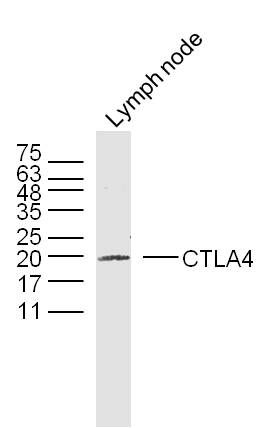 Sample: Lymph node (Mouse) Lysate at 40 ug
Sample: Lymph node (Mouse) Lysate at 40 ug
Primary: Anti-CTLA4 (bs-10006R) at 1/300 dilution
Secondary: IRDye800CW Goat Anti-Rabbit IgG at 1/20000 dilution
Predicted band size: 21 kD
Observed band size: 21 kD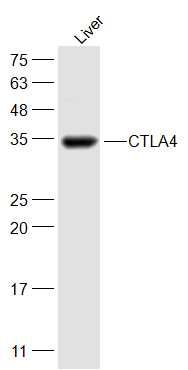 Sample:
Sample:
Liver(Rat) Cell Lysate at 30 ug
Primary: Anti-CTLA4 (bs-10006R) at 1/300 dilution
Secondary: IRDye800CW Goat Anti-Rabbit IgG at 1/20000 dilution
Predicted band size: 21 kD
Observed band size: 35 kD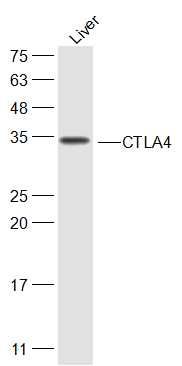 Sample:
Sample:
Liver(Mouse) Cell Lysate at 30 ug
Primary: Anti-CTLA4 (bs-10006R) at 1/300 dilution
Secondary: IRDye800CW Goat Anti-Rabbit IgG at 1/20000 dilution
Predicted band size: 21 kD
Observed band size: 35 kD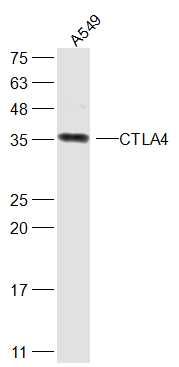 Sample:
Sample:
A549(Human) Cell Lysate at 30 ug
Primary: Anti-CTLA4 (bs-10006R) at 1/300 dilution
Secondary: IRDye800CW Goat Anti-Rabbit IgG at 1/20000 dilution
Predicted band size: 21 kD
Observed band size: 35 kD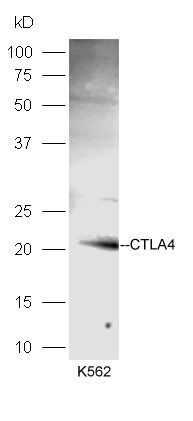 Sample: K562 Cell (Human) Lysate at 40 ug
Sample: K562 Cell (Human) Lysate at 40 ug
Primary: Anti-CTLA4 (bs-10006R) at 1/300 dilution
Secondary: IRDye800CW Goat Anti-Rabbit IgG at 1/20000 dilution
Predicted band size: 21 kD
Observed band size: 21 kD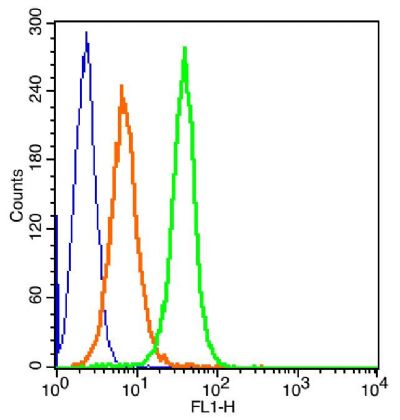 Blank control(blue): Molt-4 Cells(fixed with 2% paraformaldehyde (10 min) ).
Blank control(blue): Molt-4 Cells(fixed with 2% paraformaldehyde (10 min) ).
Primary Antibody: Rabbit Anti-CTLA4/FITC Conjugated antibody (bs-10006R/FITC), Dilution: 1μg in 100 μL 1X PBS containing 0.5% BSA;
Isotype Control Antibody: Rabbit IgG/FITC orange) ,used under the same conditions.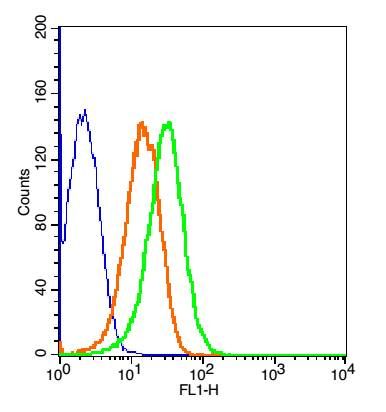 Blank control(blue):Mouse Spleen Cells(fixed with 2% paraformaldehyde (10 min)).
Blank control(blue):Mouse Spleen Cells(fixed with 2% paraformaldehyde (10 min)).
Primary Antibody: Rabbit Anti- Phospho-c-Fos (Thr325)/FITC Conjugated antibody (bs-10006R /FITC), Dilution: 1μg in 100 μL 1X PBS containing 0.5% BSA;
Isotype Control Antibody: Rabbit IgG/FITC(orange) ,used under the same conditions.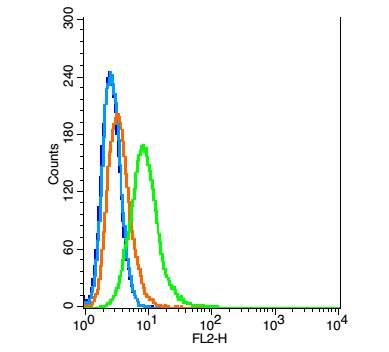 Blank control: Hela(blue), the cells were fixed with 2% paraformaldehyde (10 min)
Blank control: Hela(blue), the cells were fixed with 2% paraformaldehyde (10 min)
Isotype Control Antibody: Rabbit IgG(orange) ; Secondary Antibody: Goat anti-rabbit IgG-PE (white blue), Dilution: 1:200 in 1 X PBS containing 0.5% BSA ; Primary Antibody Dilution: 1μg in 100 μL1X PBS containing 0.5% BSA(green).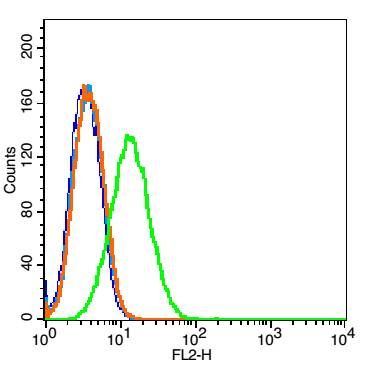 Blank control: Raji(blue).
Blank control: Raji(blue).
Primary Antibody: Rabbit Anti-CTLA4 antibody(bs-10006R), Dilution: 5μg in 100 μL 1X PBS containing 0.5% BSA;
Isotype Control Antibody: Rabbit IgG (orange) ,used under the same conditions.
Secondary Antibody: Goat anti-rabbit IgG-PE(white blue), Dilution: 1:200 in 1 X PBS containing 0.5% BSA.

